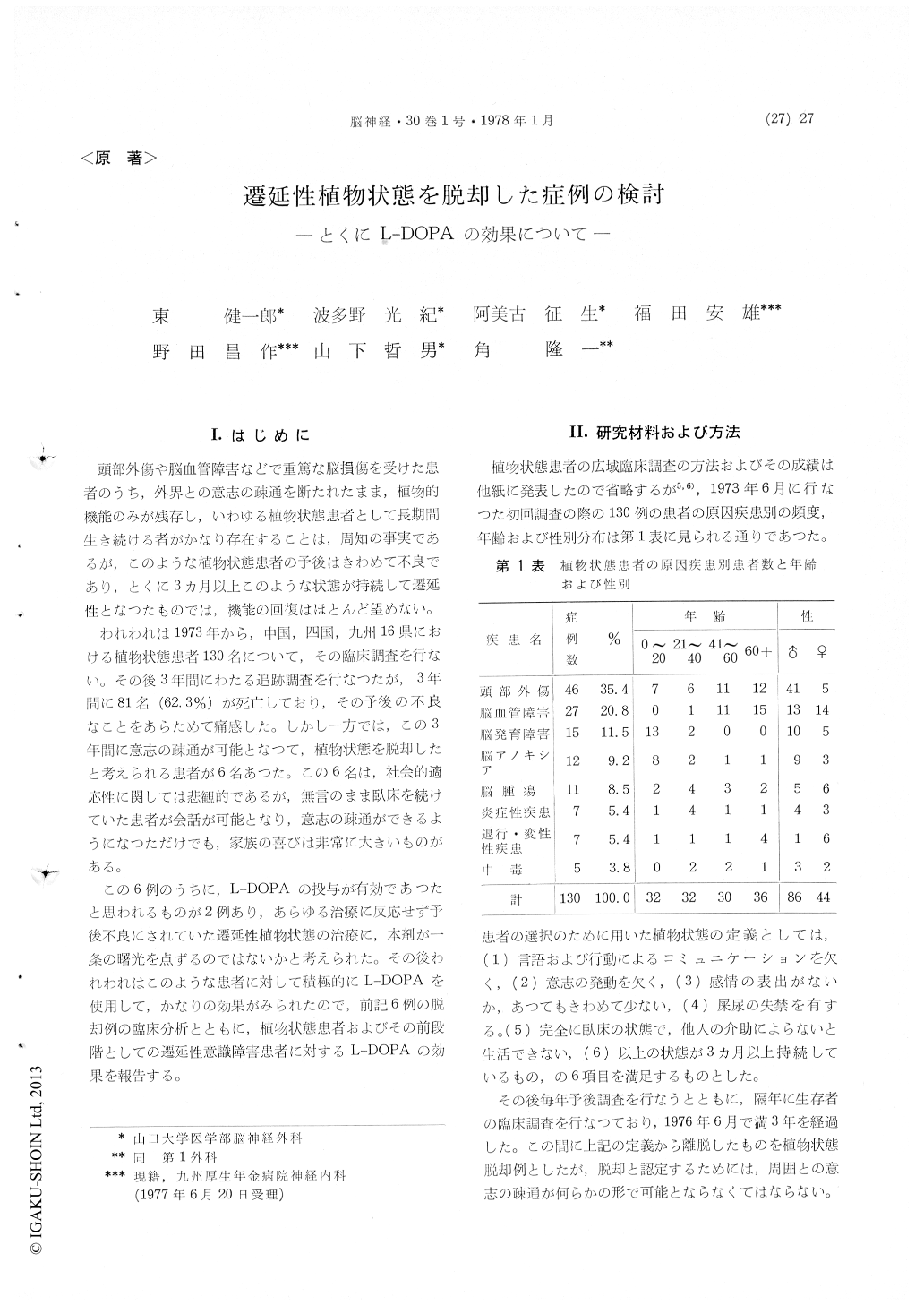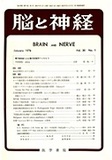Japanese
English
- 有料閲覧
- Abstract 文献概要
- 1ページ目 Look Inside
I.はじめに
頭部外傷や脳血管障害などで重篤な脳損傷を受けた患者のうち,外界との意志の疎通を断たれたまま,植物的機能のみが残存し,いわゆる植物状態患者として長期附生き続ける者がかなり存在することは,周知の事実であるが,このような植物状態患者の予後はきわめて不良であり,とくに3カ月以上このような状態が持続して遷延性となつたものでは,機能の回復はほとんど望めない。
われわれは1973年から,中国,四国,九州16県における植物状態患者130名について,その臨床調査を行ない。その後3年間にわたる追跡調査を行なつたが,3年間に81名(62.3%)が死亡しており,その予後の不良なことをあらためて痛感した。しかし一方では,この3年間に意志の疎通が可能となつて,植物状態を脱却したと考えられる患者が6名あつた。この6名は,社会的適応性に関しては悲観的であるが,無言のまま臥床を続けていた患者が会話が可能となり,意志の疎通ができるようになつただけでも,家族の喜びは非常に大きいものがある。
Since 1973 we have been conducting an epi-demiological investigation on 130 patients with persistent vegetative state resulting from severe brain damage within 16 prefectures in western Japan. The criteria of the persistent vegetative state which we adopted are as follows: (1) defect of verbal and behavioral communication, (2) loss of expression of intention, (3) absence or few instances of emotional expression, (4) urinary and fecal incontinence, (5) complete loss of selfsup-portability, (6) continuation of above conditions beyond 3 months.
Follow-up studies over 3-year period revealed that 6 out of 130 patients have recovered from their vegetative state, in spite of such extremely poor prognosis that 62.3% of the patients died during these 3 years. These 6 patients have become alert ; they became able to comprehend their sur-roundings and to communicate. They spoke and moved their limbs voluntarily. One of these patients can now converse freely and walk without support. The recovery of the remaining 5 patients, however, is limited to the extent that they are partially imcompetent mentally and/or physically. One patient comprehends well and speaks spon-taneously but has difficulty in articulation ; he cannot stand without help because of contracture of the joints on both legs but moves around in awheelchair if he is assisted to sit in it. Another patient comprehends and speaks a little, and she can stand and walk if assisted. Two patients re-spond to verbal questions but seldom speak spon-taneously; they can move their arms but are con-fined to their beds because of paraplegia. The last patient has aphasia and quadriplegia, though he can comprehend, behaving as similar to locked-in syndrome. These 5 patients seem to be hopeless concerning the social adaptability.
No common features were found in age, sex or causative diseases in these 6 patients, though the majority of them had shown good EEG records before they recovered. Presence of the signs of brain-stem involvement such as decerebrate regidity, absent pupillary light reflex, ophthalmoplegia and respiratory paralysis during acute stages did not indicate poor prognosis, because 4 of the 6 recovered patients had had these symptoms. Among the variety of therapeutic attempts, only L-DOPA was effective. Actually, 2 of these 6 patients recovered by administration of this drug.
Recently, we therefore attempted to treat such vegetative patients or patients with prolonged un-consciousness and who were destined to become vegetative with L-DOPA. Intravenous (50-100 mg per day) or per oral (via gastric tube ; 500-1500 mg per day) administration of L-DOPA was performed on 10 such patients from earlier stages. Of these 10 cases, 2 could not tolerate long-lasting admin-istration of this drug because of severe diarrhea. In 4 of the remaining 8 patients who had been given this drug continuously for periods of 1 to 6 months, L-DOPA was effective, and became per-sistently communicable. The effect of the drug became manifest 2 months after the beginning of the therapy in 3 of the 4 effective cases.
In conclusion, L-DOPA is considered to be of value in the treatment and prophylaxis of persistent vegetative state which is generally regarded as a hopeless situation.

Copyright © 1978, Igaku-Shoin Ltd. All rights reserved.


